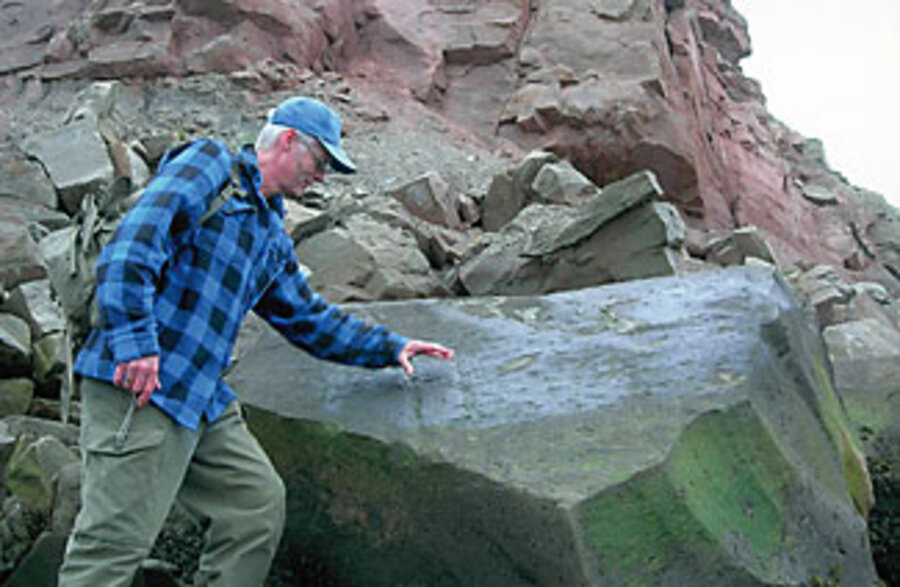Nova Scotia's pre-Jurasic park
Loading...
| Parrsboro, Nova Scotia
When you visit certain parts of Canada's Maritime Provinces, you can easily imagine yourself stepping back in time. The towns seem like towns from the 1950s preserved in amber; lifestyles are deeply rooted in the land or sea; and people move in a casual, unhurried way.
Within a short distance of Parrsboro, Nova Scotia, you can find places that go so far back in time that they predate even the world of Jurassic Park. Take West Bay, for example. A local named Eldon George told me that its cliffs are "an excellent drag site." He did not mean that these cliffs were popular for racing cars. Rather, he was referring to the fossilized drag marks and prints of prehistoric creatures preserved in the rock.
As if to prove his point, Mr. George, a dedicated amateur fossil collector, showed me the prints of a horseshoe crab. The drag mark of its spiky tail swiveled behind these prints like a miniature S.
"Maybe 250 million years ago, these little [creatures] were walking around on the sea bottom here – imagine!" he exclaimed. Indeed, little creatures were once the dominant form of life in this part of Nova Scotia. (See Fossils of Nova Scotia at http://museum.gov.ns.ca/fossils/index.htm.)
In 1984 at nearby Wasson's Bluff, George discovered a rock crisscrossed by tiny trackways, which turned out to have been made by the smallest dinosaur ever found, an animal scarcely bigger than a house sparrow.
George was more exhilarated by his discovery, an early Jurassic ancestor of Stephen Spielberg's charismatic megareptiles, than if he had found the jawbone of a T. rex. For him, size matters, but in reverse.
So there the two of us were, studying the cliff face at West Bay for evidence of Parrsboro's prehistoric past. George's 75-year-old eyes were much better at this than my somewhat younger eyes. At one point he showed me some small depressions in the rock and told me that they'd been made by pellets of ancient hail.
As we moved along the base of the cliff, we saw dozens of ancient mussel shells embedded in the rock. He also pointed out what he said might be the drag mark from the tail of a Batrachopus, a primitive crocodilian so small that a mere toddler probably could have wrestled it into submission.
We could have searched all day, but the tide was coming in, and as this was the Bay of Fundy (actually, Minas Basin), it was coming in quite dramatically. So we headed back to George's house, and he showed me one of his favorite finds – a chunk of rock that had the tracks of two mating horseshoe crabs embedded in it.
The Bay of Fundy reveals at least as much as it swallows up. Its 40- to 50-foot tides – the highest in the world – sweep against cliffs, abrading and eroding them. This activity constantly exposes fresh outcrops of rocks, each with its own potential gallery of fossils. Thus you can find new fossils on an almost daily basis ... twice daily, in fact. The idea of "new" fossils coming into the world may seem like a paradox, but on Fundy's shores it's a reality.
After leaving Parrsboro, I decided to go even further back in time, so I headed for Joggins (Micmac for "Place of Fish Weirs").
The town reminded me of the half-derelict town in Larry McMurtry's novel "The Last Picture Show," with Fundy fog replacing West Texas dust. But appearances can be deceptive. For Joggins – described by 19th century geologist Abraham Gesner as "the place where the delicate herbage of a former world is now transmuted into stone" – has recently been named a UNESCO World Heritage Site.
At the Joggins Fossil Centre, I met Don Reid, another dedicated amateur who'd been collecting fossils for more than 70 years. He showed me a fossil tree trunk and asked me to sniff it. I smelled charcoal from (imagine!) a 300-million-year-old fire probably sparked by the superabundance of oxygen in the air.
"Welcome to the Carboniferous Period," he said, and went on to tell me that local cliffs preserved the most complete record of life at the time of this fire of anywhere in the world.
With fossils, it's not always easy to tell the players without a program, so I was fortunate that John Calder, a geologist specializing in the Carboniferous, was visiting Joggins. Soon he and I – joined by a couple of local people – were going for a leisurely stroll into prehistory on the rocky beach just below town. Right away, he pointed to part of a fossilized tree trunk in the cliff face. It was nearly two feet in diameter, which made it seem more robust than delicate. Vaguely bamboolike, it also seemed somewhat familiar.
"It's a calamites," Dr. Calder said, "an ancestor of the present-day horsetail."
As it happened, a bunch of horsetails were growing nearby. They were two feet high, whereas the calamites would have been 50 feet tall or more. This prompted one of the folks who'd joined us to say: "Honey, I shrunk the horsetail."
What shrank the horsetail, in fact, was climate change. It prospered in the hot, humid climate of the Carboniferous, but did not fare well with the arrival of global cooling. Yet if the current warming trend continues, perhaps horsetails will again rise to stately heights.
Calder then showed us a diamond-shaped pattern in the rock, saying that it was from the stump of a lepidendron, an arboreal ancestor of the club moss. Once again, the ancestor would have dwarfed its descendent 20 or 30 times over.
It was inside a stump like this one, he observed, that bones from the world's oldest known reptile were found in the 1850s. He added that Hylonomus lyelli, named for Charles Darwin's mentor Sir Charles Lyell, is Nova Scotia's provincial fossil.
Fossils seem to inspire a competitive urge, so after we heard about the tree stump reptile, we began trying to find fossils new to science. At one point I noticed a strange meandering trail on an algae-covered boulder. "Look, the trackway of an ancient worm!" I exclaimed.
"Actually, it's a periwinkle's trackway from a couple of hours ago," Calder said, adding: "But many geologists have made that same mistake."
Later he showed us a trackway that resembled the tread of a Caterpillar tractor. It had been made by a prehistoric arthropod called an arthropleura. Probably similar to a millipede, the arthropleura was the largest land creature in Joggins 300 million years ago or so.
The following day, I went to hunt for fossils by myself and found myself engulfed by a dense Fundy fog. Suddenly, I heard a voice in the fog, and then a ghostlike figure seemed to materialize out of nowhere. It turned out to be a man talking loudly into his cellphone. So intent was he on his conversation that he didn't notice me. A moment later, he disappeared, although I could still hear his disembodied voice shouting in the fog.
Welcome to the present age, I said to myself.






